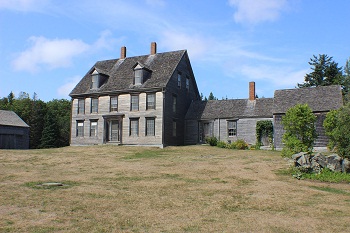How are you?
Currently, I am
introducing the stories about various artists and their paintings with the
title “Interesting
Art Stories”.
The 48th story is “Christina's
World” by Andrew Wyeth.
“Christina's World” is one of the most famous American paintings of the mid-20th century, painted in 1948 by American painter Andrew Wyeth.
 |
| Andrew Wyeth |
It is a tempera work painted in a realist style, depicting a woman semi-reclining on the ground in a treeless field, looking up at a gray house on the horizon adjoining a barn and several small outbuildings.
Today, it is one of the permanent collections of
the Museum of Modern Art in New York.
 |
| Museum of Modern Art (MOMA), New York City, USA |
The woman in the painting is
Anna Christina Olson, who was unable to walk from about 30 years old due to a
degenerative muscular disorder, but because she was resolutely opposed to the
use of a wheelchair, she would crawl everywhere. Wyeth was inspired to paint
the painting when he saw her crawling across a field as he was watching from a window
in the house.
 |
| Christina and Andrew |
Wyeth, who had a summer home
in the area, maintained a friendly relationship with Olson, using her and her
younger brother as the models of his paintings from 1940 to 1968.
The house depicted in the painting is known as the Olson House in Cushing, Maine, USA, and is open to the public, operated by the Farnsworth Art Museum.
 |
| Olson House, Cushing, Maine |
 |
| Farnsworth Art Museum, Rockland, Maine |
First exhibited in 1948 at the Macbeth Gallery in Manhattan, the painting received little attention from critics at the time. However, Alfred Barr, the founding director of the Museum of Modern Art (MoMA), purchased the painting and promoted it at MoMA, which gradually gained popularity over the years.
Today, it is considered an icon of
American art and is often perceived as the embodiment of a strong sense of longing.
The painting has been used
in various fields of popular culture.
In Arthur C. Clarke's novel
“2001: A Space Odyssey," it is one of two paintings hanging on the living
room wall of an elegant, anonymous hotel suite, to which the astronaut David
Bowman is transported after passing through the Star Gate.
 |
| 2001 A Space Odyssey, Arthur C. Clarke |
The painting is also
referenced in one of the posters of “The Texas Chain Saw Massacre (1974)”.
 |
| A poster of The Texas Chain Saw Massacre |
The cover of issue #43 of
Garth Ennis's comic series “Preacher” is a variation of the painting, and a
scene in the 1994 film "Forrest Gump" was inspired by the painting.
 |
| Christina's World, Preacher (comics) #43 |
 |
| A scene in Forrest Gump |
Thank you.





















